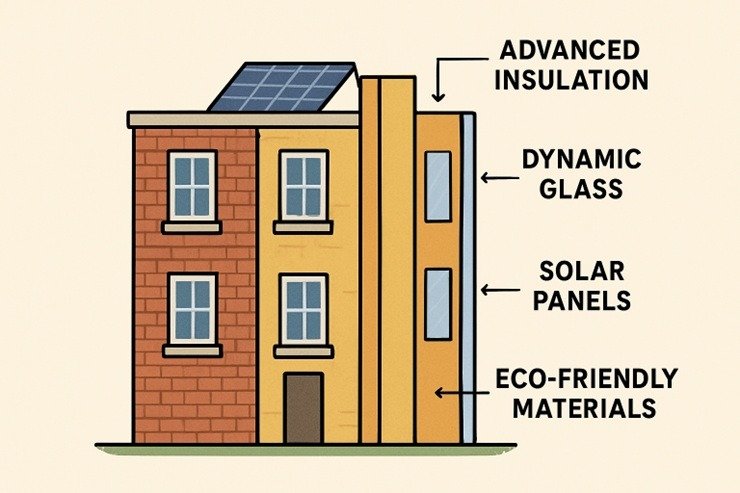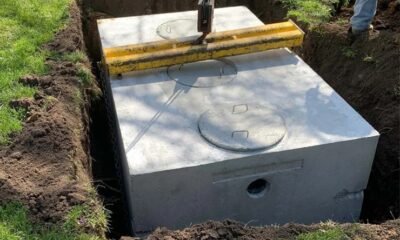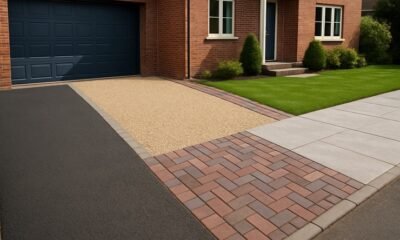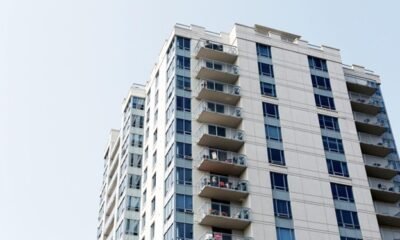Lifestyle
Innovative Strategies for Enhancing Existing Building Enclosure Performance
Key Takeaways
- Advanced insulation materials, such as aerogels and phase change materials (PCMs), significantly enhance building thermal resistance.
- Dynamic facade systems can intelligently adjust light and heat transfer, optimizing comfort and energy usage in real-time.
- Sustainable and recycled materials offer durability while supporting circular economies and environmental stewardship.
- Building-integrated photovoltaics (BIPV) transform facades into efficient, energy-generating assets.
- Prefabricated and modular retrofit kits enable rapid, low-disruption upgrades for aging buildings.
Upgrading the performance of existing building enclosures is crucial for reducing energy costs, enhancing indoor comfort, and promoting sustainability. As existing structures often account for a significant share of urban building stock, retrofits utilizing new technologies and materials represent a substantial opportunity for carbon reduction and long-term asset value. By integrating adaptable solutions and forward-thinking design, owners and facility managers can extend the lifespan and enhance the efficiency of their properties while protecting environmental resources. For guidance on evaluating and transforming older building envelopes, refer to https://www.frwconsult.com/existing-building-enclosure.
Modern strategies for envelope improvement incorporate advanced insulation, dynamic controls, sustainable components, and renewable energy integration. These approaches are revolutionizing the way buildings retain heat, reduce energy loads, and interact with exterior climates. As interest in resilient and efficient design grows, embracing cutting-edge enclosure strategies helps not only lower operational emissions but also boost comfort for building occupants. Below, we explore the most effective methods for enhancing the performance of existing building enclosures.
Advanced Insulation Materials
For many older buildings, traditional insulation methods offer limited gains due to thickness constraints or compatibility issues. New advanced materials change this calculus. Phase change materials (PCMs) stabilize interior temperatures by absorbing and releasing heat during solid-liquid phase transitions, buffering interiors from drastic swings and reducing the burden on HVAC systems. Aerogels—among the lightest and most effective insulators available—offer extremely high R-values, even in slim profiles, making them suitable for retrofitting facades where space is at a premium. The adoption of these insulation technologies can help buildings exceed modern efficiency standards and achieve better long-term comfort and savings.
Dynamic Facade Systems
Building facades are no longer static barriers; they can now actively modulate energy flow in response to environmental conditions. Dynamic systems utilize smart materials, such as electrochromic and thermochromic glass, which change tint in response to electrical signals or temperature, respectively. These technologies can minimize unwanted heat gain in summer or maximize solar collection in winter—all with minimal occupant intervention. This flexibility reduces the need for artificial lighting and climate control. Thermochromic metal halide perovskite windows, for example, offer promising efficiency improvements with seamless transitions that enhance indoor experience and cut energy bills.
Sustainable and Recycled Materials
Another major trend in envelope retrofits is the use of low-carbon, eco-friendly building materials that support circular economies. Mycelium-based composites use fungal growth to create robust, biodegradable insulation panels. Recycled plastics can be transformed into durable cladding or thermal barriers, while bamboo-reinforced products combine strength with rapid renewability. Besides reducing the need for virgin resources, these innovative products often offer unique properties such as better moisture resistance or a lightweight structure. Building with recycled and sustainable materials is an effective way of improving both environmental performance and indoor air quality.
Building-Integrated Photovoltaics (BIPV)
Integrating power generation into the very surfaces of the building is an emerging hallmark of smart, sustainable design. BIPV systems—such as solar glass curtain walls or photovoltaic roof tiles—enable architects and building owners to convert unused surfaces into solar energy producers without altering the building’s form. In the long run, this can significantly reduce a building’s reliance on external power, making net-zero energy goals achievable even in dense urban settings. Notable projects, such as the Copenhagen International School, which features more than 12,000 facade-integrated panels, showcase the viability and impact of such cutting-edge integrations.
Prefabricated Retrofit Solutions
Rapidly improving enclosure performance while minimizing tenant disruption is a priority for retrofit projects. Prefabricated solutions, such as the Hydronic Shell retrofit system, integrate insulation, HVAC, and ventilation into modular units that are fitted externally. This approach not only speeds installation and reduces mess but also creates a high-performance envelope without displacing building occupants. Prefabrication ensures quality control and minimizes construction waste, making it ideal for large-scale upgrades in urban multi-family or commercial properties.
Overcladding Strategies
Overcladding involves attaching new layers over an existing structure, both modernizing the building’s appearance and drastically improving its energy profile. Metal panel rainscreen systems, in particular, enable the addition of continuous insulation and new weather-resistant surfaces while offering design flexibility. Overcladding addresses common pain points, such as air leakage and thermal bridging, and enables visible architectural renewal, supporting both environmental and market value objectives.
Climate-Adaptive Building Shells
Adapting the enclosure’s performance characteristics in real time is the frontier of building envelope science. Climate-adaptive building shells (CABS)—utilizing sensors and active controls—regulate the flow of heat, light, and air at different times of day or year, thereby maximizing energy savings and occupant well-being. These smart shells can automatically modulate the U-value, solar heat gain coefficient, and other parameters, enabling buildings to respond dynamically to weather and occupancy patterns.
Conclusion
Enhancing the performance of existing building enclosures is among the most effective investments for future-proofing urban infrastructure. By leveraging advanced insulating materials, intelligent facade systems, sustainable construction methods, renewable energy integration, and prefabricated upgrades, property stakeholders can meet the rising demands for energy efficiency, comfort, and ecological responsibility. Embracing these innovative strategies ensures that existing properties remain valuable, livable, and sustainable for future generations.
-

 Quotes3 years ago
Quotes3 years ago53 Motivational Gym Quotes to Fuel Your Workout
-

 Quotes10 years ago
Quotes10 years ago50 Most Powerful Quotes Ever Spoken
-

 Motivation5 years ago
Motivation5 years ago4 Fun New Hobbies To Try This Year
-

 Quotes1 year ago
Quotes1 year ago100 Motivational Quotes to Inspire You in 2025
-

 Quotes2 years ago
Quotes2 years ago43 Inspirational Quotes About Thoughts
-

 Quotes3 years ago
Quotes3 years ago105 Motivational Quotes by Famous People
-

 Education12 months ago
Education12 months agoHow to Motivate Yourself to Study: 6 Proven Techniques
-

 Quotes1 year ago
Quotes1 year ago77 Morning Motivational Quotes to Kickstart Your Day

































